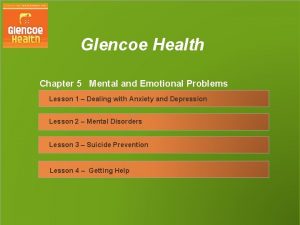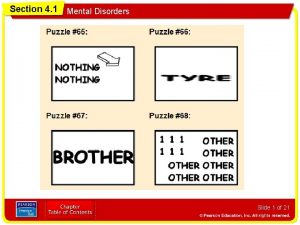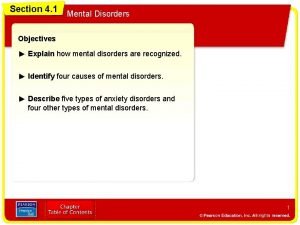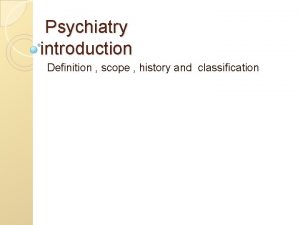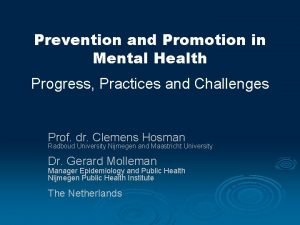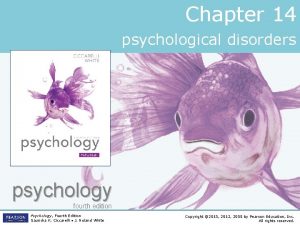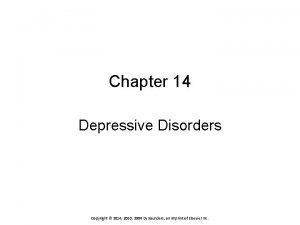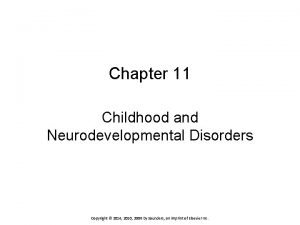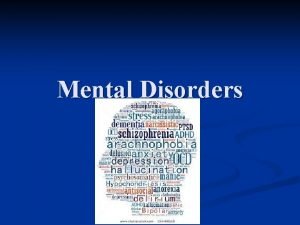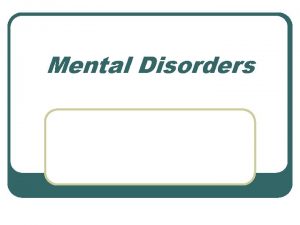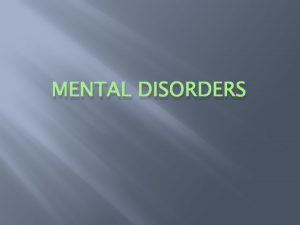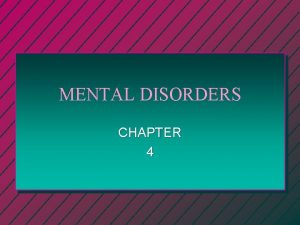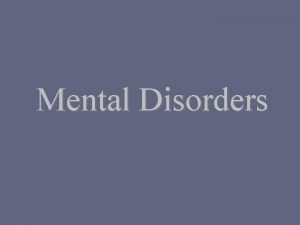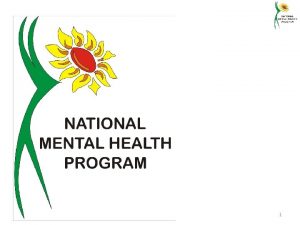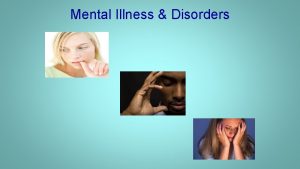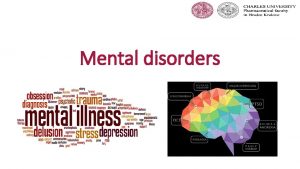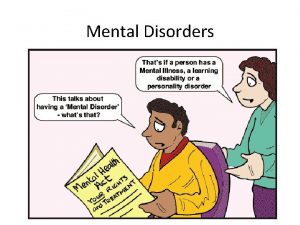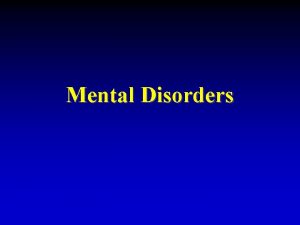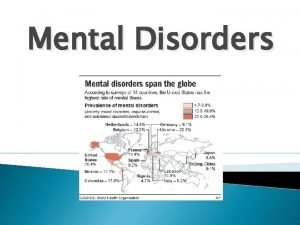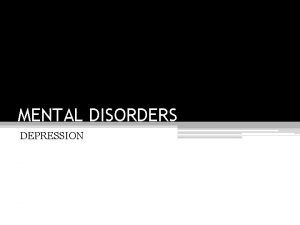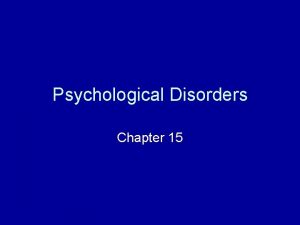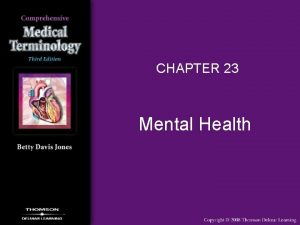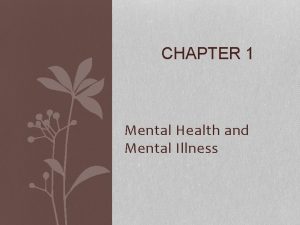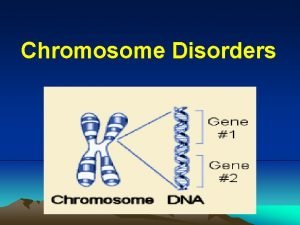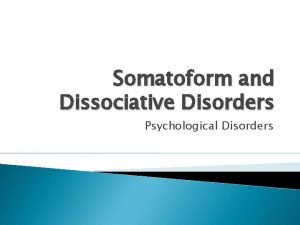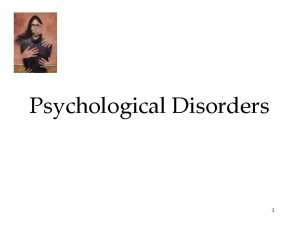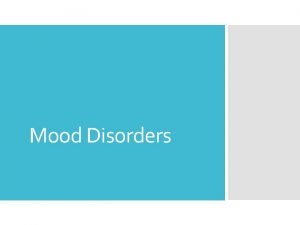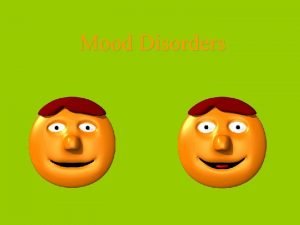Chapter 4 MENTAL DISORDERS What are mental disorders



























- Slides: 27

Chapter 4 MENTAL DISORDERS

What are mental disorders An illness that affects the mind & reduces a person’s ability to function, adjust to change or get along with others

Recognizing mental disorders Abnormal thoughts, feelings, or behaviors as signs or symptoms of mental disorder Ex. ADHD - doesn’t pay attention to detail Ex. Hyperactivity -fidgets or squirms - Makes careless mistakes -trouble staying in seat - Does not seem to listen - frequently runs or climbs - Is disorganized -talks excessively - Easy distracted -interrupts others

Causes of mental disorders Physical factors Brain damage Exposure to poison/lead heredity Early/recent experiences Ex. Children who were neglected Ex. Death of a loved one

Anxiety disorders Anxiety- fear caused by a source you cannot identify or source that doesn’t pose as much a threat as you think Anxiety disorder- when anxiety persists for a long time & interferes with daily living Generalized anxiety Phobias Panic attack OCD Post traumatic stress disorder

Anxiety disorders continued Generalized anxiety disorders Intense worry, fears, or anxiety for at least 6 months Irritability Muscle tension Trouble falling asleep Trouble concentrating Phobias Anxiety related to a specific situation Ex. Fear or small spacesclastrophobia

Anxiety disorders continued…. Panic attack Sudden for no apparent reason fear - fast heart beat -rapid breathing -fear of suffocation -sweating -trembling or shaking (p. 85) Obsessive-compulsive disorder Obsession- unwanted thought that takes control of mind Compulsion- unreasonable need to behave a certain way

Anxiety disorders continues…. Post- traumatic stress People who survive a life threatening event, may have flashbacks or nightmares

Mental disorders Mood disorders schizophrenia Extreme emotions that make it difficult to function daily Several disturbances in thinking, mood, awareness, and behavior Bipolar- manic episodes all throughout day Split mind Rarely ever harmful May talk to themselves, display inappropriate emotions, dress strange, withdraw from others Depression- emotional state when person feels extremely sad and hopeless

Mental disorders continued Impulse-control disorder Personality disorder Cannot resist the impulse, to drive, act harmful Rigid patterns of behavior that make it difficult to get along with others Ex. Gambling Group a Uncontrolled shopping Cold & distant Group b Overly emotional or unstable Group c Cannot make decisions

Review Questions 1. What is a mental disorder? How are they recognized? 2. List 4 possible causes of mental disorders 3. What is a anxiety disorder? What is the key difference between a phobia and a generalized anxiety disorder? 4. What is compulsion? How does a compulsion differ from obsession? 5. What are some symptoms of a mood disorder?

Chapter 4 SECTION 2 & 3

Eating Disorders- abnormal behaviors related to food Anoerxia Nervosa- does not eat enough to maintain healthy weight Health Risk Extremely thin (see themselves as fat and work hard to lose weight) Can starve to death Possible causes Lack of chemical that regulates mood Low self-esteem Troubled relationships Treatment Usually they deny they have disorder Doctors, and nurses have to work together

Eating Disorders Cont… Bullimia- uncontrolled eating binges followed by purging or removing food from bodies Health Risk Usually maintain normal weight Dehydration, kidney damage, and lack of vitamins & minerals Can become depressed & think of suicide Possible Causes Concerned about weight gain Treatment Often too ashamed to get help Mental health professionals can help

Eating disorders cont…. . Binge eating disorder- uncontrollable urge to eat large amount of food Health Risk- excess weight gain & unhealthy dieting Diabetes and high blood pressure Possible Cause To avoid dealing with difficult emotions, food is a relief Treatment Need help with dieting and may need to slow down

Essential Questions 1. What is a eating disorder 2. What health risks are associated with anorexia? Why are people unlikely to ask for help? 3. What is bulimia? Explain the connection between bulimia and dieting? 4. What health risks are possible for someone with binge eating disorder?

Section 3: Depression & Suicide

Clinical Depression It is normal to feel depression at times. Clinical depression- sad & hopeless for months & unable to enjoy activities. Cause problems at home & school. If untreated can lead to substance abuse, serious behavior problems, and suicide Recognize depression (p. 95) Risk factors Parent with mood disorder, major life change, victim of crime, hopelessness, & previous bout of depression Treatment Medication & mental health experts

Self- Injury Cutting- The use of sharp objects to intentionally cut or scratch one’s body deep enough to bleed Burning the skin Occurs most often in young women Unhealthy way to cope with stress Usually not trying to kill themselves Mental Help is needed

Suicide Prevention Suicide- the intentional killing of oneself 3 rd Leading cause of death among people between 15 -24 Risk Factors Previous attempt or family history Having both mental disorder and substance abuse disorder Lack to access mental health treatment Being influenced by family members, peers, or celebrities

Suicide cont… Protective factors Treat person’s mental disorder Having personal beliefs that discourage suicide Knowing how to resolve conflict in no-violent ways Cluster Suicides A series of suicides that occur within a short period of time Usually a pact between friends Immediate counseling can prevent cluster suicides

Suicide continued…. . Warning Signs Most occur without warning Sudden drop in grades, increase in drug use Helping Others Make your friend make a promise Notify an adult Remember suicide is a call cry for help dealing with problems Helping Yourself Suicide is never a solution Talk with someone, like a trusted adult Crisis center and suicide prevention hotlines

When a friend is thinking about suicide. Do Trust your feelings Take threats seriously Say how concerned you are Listen carefully Talk calm Involve a trusted adult Stay until help arrives Do NOT Dare the person to go ahead with suicide attempt Judge the person Analyze the persons motives Argue Leave the person alone

Essential Questions 1. How do mental health experts diagnose clinical depression? 2. Why is it important to identify and treat clinical depression? 3. Describe self-injury. 4. What is a major risk factor for suicide? 5. What is cluster suicide?

Section 4

Treating Mental Disorders 20% of Americans experience symptoms of mental disorder, most do not seek help Sometimes people don’t even recognize the signs Sometimes they are told they can have willpower to overcome First Step- Recognize the need for help Do not ignore warning signs & don’t self diagnose Treat disorder same way you would for being sick Share issue with an adult you TRUST

Types of Mental Health Professionals Psychiatrist- a physician who can diagnose and treat mental disorders. Clinical Psychiatrist Trained to recognize and treat behavior that is not normal Interview patient and use a diagnostic test Social Worker Listen to and advise people Act as a link between people who need help and community resources Mental Health counselors Focus on specific problems and work with specific groups Ex. Substance abuse, school counselors, pastors
 Mikael ferm
Mikael ferm Chapter 21 mental health diseases and disorders
Chapter 21 mental health diseases and disorders Impulse control problems
Impulse control problems Chapter 5 lesson 4 getting help
Chapter 5 lesson 4 getting help Chapter 20 mental health and mental illness
Chapter 20 mental health and mental illness Section 4-1 mental disorders answers
Section 4-1 mental disorders answers Section 4-1 mental disorders answers
Section 4-1 mental disorders answers Derealiation
Derealiation Mental health disorders
Mental health disorders Mental health coping skills jeopardy
Mental health coping skills jeopardy Chapter 18 psychological disorders
Chapter 18 psychological disorders Concept mapping chapter 11 genetic disorders
Concept mapping chapter 11 genetic disorders Chapter 8 skin disorders and diseases
Chapter 8 skin disorders and diseases Chapter 6 musculoskeletal system diseases and disorders
Chapter 6 musculoskeletal system diseases and disorders Chapter 46 digestive and endocrine disorders
Chapter 46 digestive and endocrine disorders Chapter 29 somatic symptom and dissociative disorders
Chapter 29 somatic symptom and dissociative disorders Chapter 29 endocrine and metabolic disorders
Chapter 29 endocrine and metabolic disorders Chapter 18 psychological disorders
Chapter 18 psychological disorders Chapter 18 eating and feeding disorders
Chapter 18 eating and feeding disorders Chapter 17 reproductive system diseases and disorders
Chapter 17 reproductive system diseases and disorders Chapter 15 nervous system diseases and disorders
Chapter 15 nervous system diseases and disorders Chapter 15 anxiety and obsessive-compulsive disorders
Chapter 15 anxiety and obsessive-compulsive disorders Chapter 14 psychological disorders
Chapter 14 psychological disorders Chapter 14 depressive disorders
Chapter 14 depressive disorders Chapter 11 childhood and neurodevelopmental disorders
Chapter 11 childhood and neurodevelopmental disorders Seborrheic keratoses
Seborrheic keratoses 10 nail diseases and disorders
10 nail diseases and disorders Milady chapter 10 nail disorders and diseases
Milady chapter 10 nail disorders and diseases


